
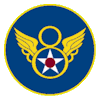

April 18, 2010
Volume II, Issue 6
www.303rdBG.com
and Major General Lewis E. Lyle
The Barksdale Air Force Base, Louisiana B-17G will be repainted as "Miss Liberty" #42-31340
(360th BS) PU-D, as flown by LtCol Lyle on Mission #125, March 22, 1944 to Berlin.
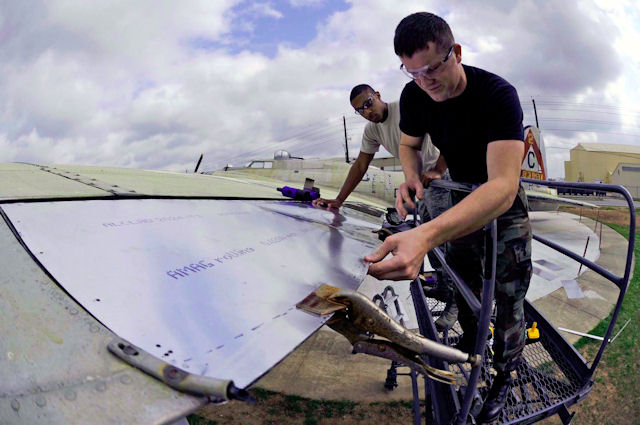
Airmen 1st Class Bronson Bohannon (right) and Avondries Green install rivets on new sheet metal wing flaps
April 5, 2010, at Barksdale Air Force Base, La. Airmen Bohannon and Green are 2nd Maintenance Squadron aircraft
structural maintainers. (U.S. Air Force photo/Staff Sgt. John Gordinier)
by Staff Sgt. John Gordinier
2nd Bomb Wing Public Affairs
4/14/2010 - BARKSDALE AIR FORCE BASE, La. (AFNS) -- Airmen, volunteers and contractors here are busy preserving, restoring and painting a B-17G Flying Fortress for the 8th Air Force Museum in honor of Maj. Gen. Lewis E. Lyle, a World War II B-17 pilot.
The aircraft being restored will be preserved to the best extent possible and replicated as the B-17G that General Lyle flew March 22, 1944, said Master Sgt. Keith Baron, the 8th AF museum restoration and maintenance superintendent.
Twenty-eight aircraft took off from Molesworth, England, that day to bomb the Ernest Heinkel aircraft factory at Oranienburg, Germany. The second target was the Friedrichstrasse Station in Berlin. Then–Lt. Col. Lyle, the 303rd Bomb Group deputy commander, flew the B-17 "Miss Liberty" and was the aircraft formation lead.
Intelligence officials told the team the Heinkel plant was producing about 30 German He-177s per month. 8th AF officials wanted to shut it down if weather permitted; however, the weather didn't cooperate, and the team moved to their second target.
The aircraft dropped more than 1,000 65-pound bombs from 27,000 feet on Berlin. General Lyle described the mission as "a darned good mission."
"We really hit Berlin," he said. The fighters gave the bombers "more than good support" that day, and the bomber pilots didn't see any German fighters, the general said. "We didn't see the results of our own bombing until after we left the target. We were too busy dodging flak."
General Lyle's co-pilot, Maj. Walter Shayler, said they dropped their bombs near the river and "they really hit something."
"There was one big burst of red flame that shot thousands of feet into the air, clear through the clouds at 8,000 feet," he said.
Nine hours after takeoff, all the bombers landed back at Molesworth with mission success. Most of the bombers received flak damage, but that was considered usual over Berlin. Two crewmen suffered frostbite, but no one was severely injured.
"Our B-17G is one of approximately 30 or so B-17s left in the world, and only about five of those are in flying condition," Mr. Miller said. "Considering how rare it is, we must preserve and restore it. It will accompany the 303rd Group monument to General Lyle located next to the aircraft."
The Barksdale B-17G was the second to last made by Douglas Aircraft Company under contract with Boeing, and rolled off the assembly line in July 1945.
"This one was produced as bare aluminum with no paint on its skin," Sergeant Baron said. "To save manufacturing time, very few B-17Gs had paint. However, the "Miss Liberty" B-17G that General Lyle flew during the mission in 1944 had paint; and we are going to replicate that down to the tail number -- 42-31340.
"It is very important that we preserve the remaining artifacts from that time period so that the stories and the sacrifices made are not forgotten altogether," Sergeant Baron said. "One of our missions here in the museum is to do just that; preserve and protect so that others may learn."
"General Lyle was an aviator's aviator," said Gary Miller, the 8th AF museum director. "He was the most decorated (pilot) in the 8th AF and he later (became) a general with Strategic Air Command. If you had to pick a hero of 8th AF, it was him flying 72 combat missions over Germany."
General Lyle continued his Air Force career and retired July 1, 1967. He passed away April 6, 2008 at the age of 92.
by Rick Collier
GlennCollier@semtribe.com
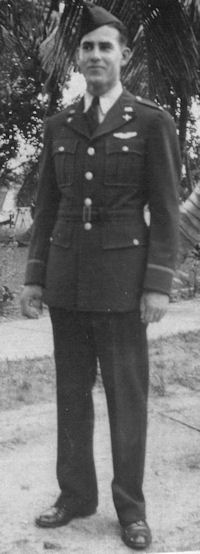 George Sterling McClellan, Jr., known as Sterling to his family, was my first cousin. I never knew him. He died eight years, ten months, three weeks, and one day before I was born. He died on January 11, 1944 somewhere over Germany. He was the pilot of a B-17 bomber on a mission to bomb a Junkers aircraft factory located in Oschersleben, Germany. He and his crew were shot down before they were able to deliver their bombs on that fateful day.
George Sterling McClellan, Jr., known as Sterling to his family, was my first cousin. I never knew him. He died eight years, ten months, three weeks, and one day before I was born. He died on January 11, 1944 somewhere over Germany. He was the pilot of a B-17 bomber on a mission to bomb a Junkers aircraft factory located in Oschersleben, Germany. He and his crew were shot down before they were able to deliver their bombs on that fateful day.
My dad was Sterling's uncle and although most uncle nephew relationships are marked by significant age differences, my dad was only four years older than Sterling. Their relationship tended to be more like cousins than a typical uncle nephew relationship. They were in fact quite close and did many things together. They were both avid hunters and they loved to hunt quail with their bird dogs. My dad also liked to share how he and Sterling double dated on many occasions before my dad married my mom.
I can't really remember when I didn't know who Sterling McClellan was and what he had done in World War II. I must have been pretty young when my dad first told me about Sterling and about his dying during the war. As I look back on that I know my dad wanted to keep the memory of Sterling alive for those who had not known him. Many people in our city were familiar with the name Sterling McClellan. Our local American Legion Post was named in his honor. I had seen the big portrait of him hanging on the wall in the American Legion building. He was in full military uniform and he was a very good looking man.
As I grew older and became a young man I didn't really think a whole lot about Sterling McClellan. The truth is I didn't think about him at all. I was married and my wife and I had three young daughters when I began to think about Sterling again.
I decided to take my oldest daughter, Carolyn, who was seven at the time, to the Memorial Day ceremonies at our city cemetery. The American Legion Post and the Veterans of Foreign Wars organized a parade and ceremony each Memorial Day to honor those who had given their lives in the service of our country.
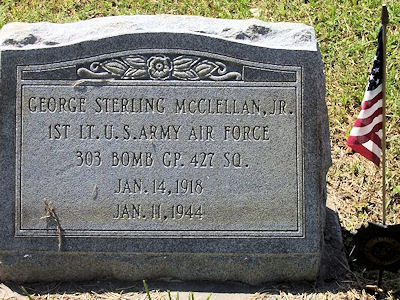 |
When the honor guard fired their last shots we heard a low rumbling sound heading our way. We looked up to see three vintage World War II airplanes fly directly overhead. They were the C-47, the B-24, and the B-29. This was not planned by any human being, these planes had been at a local airport on exhibit and they just 'happened' to fly overhead as the last shot was fired by the honor guard.
Sterling flew the B-17 and I was a little disappointed his plane was not represented in the fly over. But as I thought about it later I began to think it was perfect it was not there, the plane Sterling was shot down in was missing from formation.
Carolyn and I dropped by my parent's house on the way home from the cemetery. I asked my dad about Sterling and what he was like. My dad, who rarely showed his emotions, stopped and thought for a moment. I could see a wistful look in his eyes as he went back in time. When he began to speak his voice was very soft and deliberate as he said, "Sterling was a special man, a very special man." That's all he said and I could see sadness come over my dad that I rarely ever saw.
I didn't ask him any more questions. As Carolyn and I left, I knew the seed had been planted to find out more about this man, George Sterling McClellan. Who was he, what was he like, and what had happened to him on that last mission he flew over fifty years before?
I began my research by talking to friends and family members of Sterling. Sterling had been born in rural South Carolina a few miles outside the small town of Elloree. He came to Pompano Beach, Florida, with his mom, dad, and younger sister when he was three and a half years old.
His dad, Dr. George McClellan, was a medical doctor and he became the first full time doctor in residence in the Pompano area. His mom was my dad's oldest sister, her name was Novice. Pompano was a very small agricultural community when Sterling grew up. Anyone who needed any kind of medical assistance came to Dr. George. Everyone knew Dr. George and his family.
As I talked to men and women who had grown up with Sterling a consistent description began to emerge. He was good looking, intelligent, great sense of humor, athletic, honest, loyal, selfless, champion of the underdog, man of character and integrity.
Sterling had two brothers and a sister. One brother had passed away but his sister, Novice, and brother, Billy, were still alive when I began my research of him. Novice lived in our area but Billy had moved to North Carolina. I phoned Novice one day and asked if I could talk to her about Sterling. She graciously agreed and invited me to come to her home. I could tell from the beginning of our conversation that she still loved and missed Sterling very much even fifty years after his death. I could really sense the deep emotions Novice felt for her brother as she shared different memories of him.
As I drove home that day I thought, "This man seems too good to be true." I began to wonder if maybe I was talking to the wrong people. Not that anyone was knowingly misrepresenting Sterling. But the thought crossed my mind that maybe when someone dies young, especially in the service of their country during wartime, maybe the memory of that person becomes a little skewed in an overly positive biased manner.
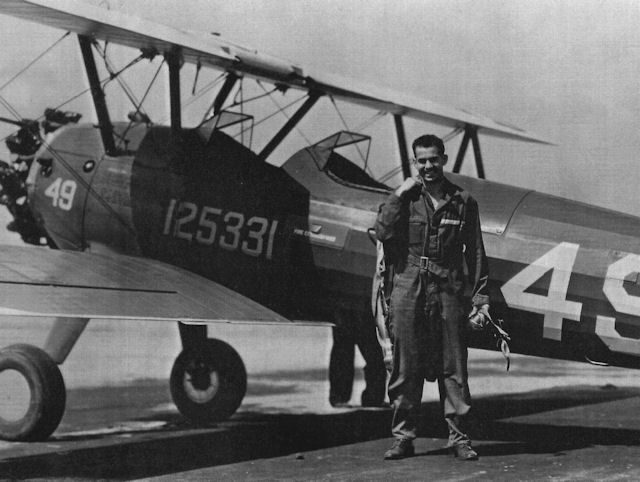
In researching his military career I discovered Sterling was a member of the Eighth Army Air Force, 41st Combat Wing, 303rd Bomb Group, and 427th Squadron. I also found out the 303rd Bomb Group published a quarterly newsletter. I decided to write a letter to this publication asking if anyone knew Sterling during the war and could they give me some information on him if they did. [Rick's letter appeared in the Hell's Angels Newsletter, November 1994.]
I honestly wasn't too hopeful of hearing from anyone who had known Sterling. But a couple of weeks after the newsletter went out with my request I received a letter in the mail. It was from a man named Lawrence A. Peacock. He had served in the 303rd Bomb Group and 427th Squadron with Sterling. Astonishingly he only lived seventy miles south of me. He gave me his phone number and said he would be glad to meet with me to talk about Mac. That was a new one. I assumed Sterling and Mac was the same guy.
I phoned Mr. Peacock and he invited me to come visit him and his wife. He said he would do his best to answer any questions I had about Mac. I was a little nervous meeting someone I didn't know but Mr. and Mrs. Peacock made me feel right at home.
Mr. Peacock was a 1st Lieutenant during the war. He served as a navigator on a B-17. Although he had grown up in Miami just thirty miles south of Pompano he had never met Sterling until they were stationed at the Molesworth Airbase north of London, England, in 1943.
Mr. Peacock told me he only knew Mac for about four months before he was shot down. But he said in those four months, Mac had made an impression on him that he's never forgotten and never would. He said Mac was one of those special individuals you come across once in a lifetime.
He said Mac was confident and sure of himself but not cocky or arrogant. He was as humble and unselfish a man as he had ever met in his life. He said Mac on several occasions had taken his plane out of formation to protect other planes in their squadron that had been shot up and in trouble on the way back to England after a bombing mission over Germany.
Mr. Peacock went on to tell me of the mission on which Sterling was shot down. He said their formation was attacked head on by German Focke-Wolfe 190 fighter planes. Because Mr. Peacock was a navigator he had a good view from his position of the other planes in their squadron. But he could not see Sterling's plane that day because Sterling's B-17 was flying behind Mr. Peacocks in their formation.
Mr. Peacock said the tail gunner on his plane, who was positioned at the rear of the plane, saw Sterling's plane attacked repeatedly by FW 190's and he watched as it dropped out of formation and began to lose altitude. He said several parachutes were visible coming out of the stricken bomber and that was the last he saw as they flew out of range.
As Mr. Peacock relived this memory for me his face took on an anguished look and he was silent for a few seconds. Then he looked at me and said, "If someone stayed with the plane long enough and it went into a tight spiral, centrifugal force would not allow them to exit the plane." That's all he said. I could tell he was emotionally drained from sharing that with me.
He and his wife took me to lunch. They were very kind to me. I was a complete stranger to them yet I knew I was being treated very special because of my cousin whom I had never known by someone who had.
I wondered as I drove home that day if Sterling had become trapped in his plane and couldn't get out. I resigned myself to the fact I would never know.
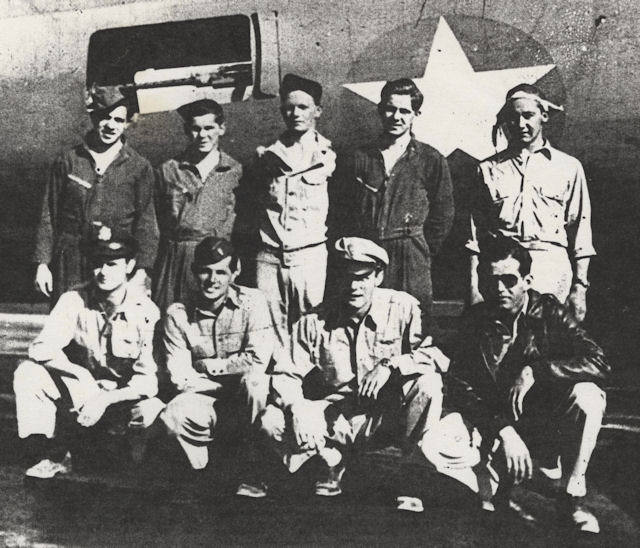
(Back L-R) T/Sgt David Tempesta (E)(KIA), S/Sgt Robert G. Yarian (BTG-POW), Sgt Selig (R)(not with crew in England),
S/Sgt Charles E. Dugan (TG)(POW), S/Sgt Robert H. McGrew (WG)
(Front L-R) 2Lt Ernest G. Greenwood (CP), 2Lt Merlin L. Cornish (B)(POW), 2Lt John C. Kaliher (N)(POW), 1Lt George Sterling McClellan (P)(KIA)
A few weeks after my meeting with Larry Peacock, I received another letter in the mail. This letter was from a young man whose grandfather had been Sterling's co-pilot. In an odd twist of fate this man was not on the flight the day Sterling was shot down. A new pilot in training sat in the co-pilot's seat that day. This young man shared with me the different emotions his grandfather had felt over the years not being on the plane that day with his crew and friends.
The young man who had written me told me that six men had survived from Sterling's crew. All six had been captured by the Germans and became POWs for the duration of the war. He believed all had passed away except for one. He gave me this man's name and where he lived. I was able to get his phone number and called as soon as possible. My heart sank when his wife told me her husband had passed away six months before.
Not long after this Novice called me and told me she had some correspondence and photos dealing with Sterling and that I was welcome to borrow them and make copies if I so desired. I found a letter written to Sterling's father by his navigator, 2nd Lt. John C. Kaliher, who had survived and been captured by the Germans. It was written two weeks after he arrived back in the United States from being a POW.
It is a first hand account of what took place the day Sterling was shot down. Here is the letter in its entirety. Please note that Sterling is referred to in this account as George, this was his first name and obviously was used by some of his crew members.
Dear Dr. George McClellan:I had what I had been looking for in my hands, an eyewitness account of what had taken place on the plane that day. There were still some unanswered questions. Did Sterling and the co-pilot get out of the plane or had they waited too long and were unable to bail out?Introducing myself, I am John C. Kaliher navigator of your son George's B-17, the "Bad Check." I was released from prison camp in Germany and arrived home two weeks ago. While in France, I met your other son and told him the little bit I knew concerning our crew's last mission. I am writing you rather than his mother, as reading this letter might cause her to feel even more badly.
The morning of January 11, we were on our way to bomb Oschersleben, Germany. Shortly after crossing the Holland, Germany border, we were attacked by German fighter planes. As we received repeated attacks, George put the plane thru evasive action to throw off the German aim. After several attacks we took battle damage and began to lose altitude. George called over the inter-phone and told us to prepare to "bail-out." I put on my parachute and crawled back up into the pilot's compartment to see how they were and also find out whether we were going to bail out or crash land. On entering the Pilots compartment I saw our Top-turret gunner, Dave Tempesta, lying dead. George and the co-pilot, William Fischer, were both unhurt. George said we would have to "bail-out" and told me to get the bombardier, Merlin Cornish, and jump. I went back up in the nose of the ship, told the bombardier, and destroyed my navigational equipment which was of a secret nature. While in the nose I remembered our passing over a heavy cloud layer a few minutes before and decided to ask George if we could make a dive for the clouds, and thus escape from the German fighter planes. I went back up in the pilot's compartment and asked George if we could dive for the clouds. He said "no" as the plane was too damaged. George was standing behind his seat and the co-pilot was sitting in his seat. George was a little pale, but both he and the co-pilot were unhurt. The plane was on automatic-pilot at that time. George asked me to find his parachute. I reached down in the hatch between the pilot's seats and picked up the parachutes. I handed George his, as he was standing and put the co-pilots chute in the co-pilots lap. George had some trouble hooking his chute to his harness, so I helped him hook it, then he told me to get the bombardier and bail out. I went into the nose, told the bombardier, and we bailed out the forward hatch. After I pulled the rip-cord I looked around for the other boys' chutes, but saw none. I caught a glimpse of the plane and was still circling. I was captured within a few minutes after I hit the ground. That was about eleven thirty A.M. At four P.M. I saw our bombardier, Merlin Cornish and asked him if he had seen anyone else of our crew. He said, "no." About a week later we saw, Charles Dugan, our tail-gunner and Heaton, our waist gunner. They told us the ball-turret gunner was in the hospital with wounds, but had no information as to the rest of the crew. Lt. Merlin Cornish and I were sent to an officers prison camp, where in August I received word from my wife of the death of George and our co-pilot, William Fischer. Up to that time, the bombardier and I had hopes that George and the co-pilot had either evaded capture or were in another officer's prison camp. I am very sorry that I have so little information for you.
I do want you to know that if skill were all that were needed on that last mission that George would have gotten the plane and crew back to England. His superb flying ability was overcome by the huge number of enemy planes that attacked us on that day. As the length of time George kept the plane flying, in spite of attacks and battle damage, was miraculous. If I can be of any help to you please let me know.
Sincerely,
John Kaliher
2nd Lt. A.C.
Chicago
I believe Sterling sat back down in the pilot's seat to make sure everyone else was out before he attempted to exit the plane. I believe he stayed too long and was unable to get out before the plane eventually crashed.
I thought the story was over, that I had found what I was looking for, but three people are mentioned in Lt. Kaliher's account that would provide a dramatic twist to an all ready incredible story.
Lt. Kaliher mentions in the beginning of his letter to Dr. McClellan that he spoke to his other son in France after being released from his prisoner of war camp. This "other son" was Sterling's younger brother, Billy, who had also been a POW in Germany for over a year.
I hadn't spoken with Billy about Sterling but he had since moved back to our area from North Carolina and I felt compelled to talk to him if he was willing. I called him up and asked him if I could talk to him about Sterling and his own war experiences. He was very friendly and invited me over to his home to speak with him. I was certainly not prepared for the story he was about to share with me.
On February 25, 1944, six weeks and three days after Sterling's B-17 Flying Fortress had been shot down, S/Sgt. Lucius William McClellan sat in a B-24 Liberator waiting to take off from a U.S. airbase in Manduria, Italy. He was a member of the 15th Army Air Force, 47th Combat Wing, 450th Bomb Group, and 722nd Squadron. Billy was one of a crew of ten and he was one of two waist gunners on his B-24. He manned a .50 caliber machine gun. His job was to shoot down any enemy aircraft that got within range of his gun.
Looking at a map of Italy the southern section looks like a giant boot or shoe. Manduria is located in the heel section of this giant boot. Billy's Bomb group was headed to Regensburg, Germany on this day to bomb the Prufening Messerschmitt Aircraft Assembly Plant.
They took off and flew almost due north over the Adriatic Sea. Regensburg is the capital of Bavaria and located in southern Germany. According to the official records their group was attacked by enemy aircraft approximately three hundred miles from their intended target.
They made it through these initial attacks plus heavy concentrations of anti-aircraft fire until they were about thirty miles south southeast of Salzburg, Austria. At this point Billy's B-24 the Tanta Liza dropped out of formation. The official missing aircrew report lists anti-aircraft fire as downing the plane.
Billy was hit by shrapnel of some sort and knocked unconscious. His flak jacket saved him from catastrophic injury but he was unconscious and his plane was going down. The pilot had given orders to bail out and the only thing that saved him was a fellow crew member got him to his feet and was able to get one of Billy's hands on his ripcord. Billy regained consciousness and was able to pull his ripcord when he exited the plane.
He was captured soon after he landed and was taken to a hospital to have his wounds tended. After a stay in the hospital, he was released and then interrogated. He was then assigned to Stalag 17B located a few miles from Krems, Austria.
Stalag 17B was one of the largest German POW camps and one of the most notorious. It housed POWs of many nations. Besides Americans, there were British, French, Italians, Russians, and several other nationalities. The majority of American POWs in Stalag 17B were enlisted men from the Army Air Force. These men were survivors of the B-17's and B-24's shot down on bombing missions over Germany or countries the Germans occupied.
At one point during World War II Stalag 17B housed over 4,200 American servicemen and over 25,000 POWs from other countries. The Germans kept the POWs in separate compounds according to nationalities.
Stalag 17B was not a pleasant place to be. Food was short and treatment by the German guards could be brutal at times. The living conditions were spartan to say the least. S/Sgt. McClellan was subjected to these conditions along with his fellow American service men.
He hadn't been in Stalag 17B very long before he was approached by two fellow Americans. They had noticed his last name and they wanted to know if he was related to 1st Lt. George Sterling McClellan. Billy told them he was Sterling's brother.
They identified themselves as S/Sgt. Bernell Heaton and S/Sgt. Charles Dugan. They proceeded to tell Billy they had been crew members on Sterling's plane the "Bad Check." Billy had been notified of Sterling's plane being shot down but he did not know at the time and neither did S/Sgt.'s Heaton or Dugan if Sterling had survived. Billy said S/Sgt. Dugan pulled him to the side and said, "I have something I want to tell you." He went on to tell Billy, "I was late returning to the base after a temporary leave and I was put on restriction from flying. Your brother went to bat for me with the base commander and he got me back flying after missing two missions. Your brother was good to me and I am going to do everything I can to help you while we're in this camp."
Billy said Dugan was true to his words. He shared his food with him, and did everything in his power to lift his spirits. When Billy was done sharing this story with me he looked directly into my eyes and said in a voice barely audible, "I don't think I would have survived that time as a POW if Dugan hadn't helped me get through it." Jesus said, "Greater love has no man than this that he lay down his life for his friends." The giving of one's life for another is always the ultimate sacrifice. The amazing thing about this story is I don't think it ever crossed Sterling's mind that when he was saving the lives of his crew members he was also saving the life of his beloved brother Billy.
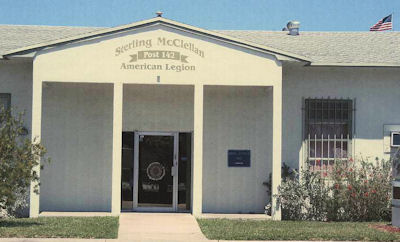 |
Life and death confronted Sterling McClellan twenty five thousand feet over Germany in his stricken B-17 bomber. His top turret gunner lay dead behind him. The cold frigid air swirled through his shot up plane as the engines roared around him. He had a rookie co-pilot sitting next to him. The desire to survive must have been overwhelming, yet he stayed with his plane so his remaining crew members could get out in time.
1st Lt. George Sterling McClellan died three days shy of his twenty-sixth birthday. He's been gone a long time now. But the truth is men like Sterling McClellan never really die they seem to live on forever.
![]()
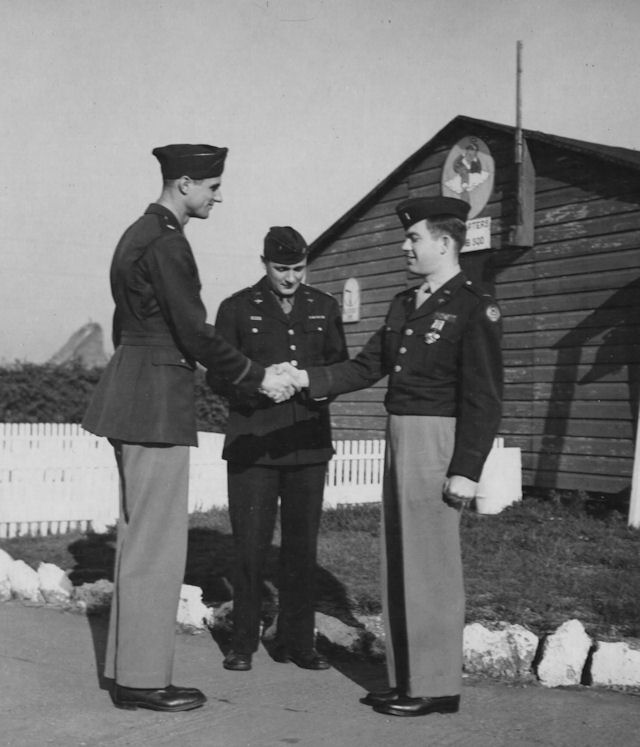
15 April 1945: 1Lt Robert M. Garret, 358th BS Navigator on the 1Lt William C. Davis Crew
receives the Distinguished Flying Cross.
Happy Birthday, Colonel Clifton! Beautifully done!
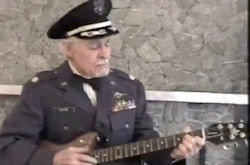 On May 3, 2010, 360th BS pilot Dave Clifton will turn 90 years old. For his birthday, his son David produced a short video of his experience as a B-17 pilot. The video has Colonel Clifton singing about the war, life, and love in his version of "The Last Farewell." It contains B-17 photos and two of his most memorable combat missions. Son David says, "I think his song and story captures the experiences of many of the young men who served in the 303rd Bomb Group. What would make this birthday video even more special is if you could distribute it to your 303rd mailing list and ask them to post comments." Today, Dave is living in Pompano Beach, Florida with his "inspiration," Ruth.
On May 3, 2010, 360th BS pilot Dave Clifton will turn 90 years old. For his birthday, his son David produced a short video of his experience as a B-17 pilot. The video has Colonel Clifton singing about the war, life, and love in his version of "The Last Farewell." It contains B-17 photos and two of his most memorable combat missions. Son David says, "I think his song and story captures the experiences of many of the young men who served in the 303rd Bomb Group. What would make this birthday video even more special is if you could distribute it to your 303rd mailing list and ask them to post comments." Today, Dave is living in Pompano Beach, Florida with his "inspiration," Ruth.
Contact David Clifton at davidclifton@gatech.edu To view the video, click on the photo, or this link http://www.youtube.com/watch?v=-wz7fLinrzU
David, tell your dad "Happy Birthday" from his friends in the 303rd. Viewers might be wise to have some tissues nearby when watching this touching tribute.
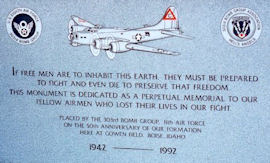 303rd Memorial, Gowen Field
303rd Memorial, Gowen FieldThe 303rd Bomb Group Memorial, located at Gowen Field, Boise, Idaho, is being moved to the new Gowen Field Memorial Park. The Memorial was placed by the 303rd Bomb Group Association in 1992 on the 50th anniversary of Gowen Field. The new location of the Memorial will be in a prominent place in the WWII section of the newly dedicated Memorial Park. A ribbon cutting ceremony will take place on May 27, 2010. More information will follow in the next issue of "The Molesworth Pilot."
Eighth Air Force Reunion – Tucson, Arizona – July 21-25, 2010
Registration is now underway for the 2010 8th Air Force Reunion this July in Tucson, Arizona. Registration information is in the March 2010 issue of the 8th AF News or online here: http://www.8thafhs.org/reunions.htm. We're looking for a good turnout from our 303rd Bomb Group veterans, families and friends.
"Thunder over Michigan"
The Largest Gathering of Heavy Bombers in the World
The 8th Air Force Historical Society is hosting veterans, family members, and their guests at the Willow Run Air Show, located just outside Detroit, August 5 thru 8, 2010. The Air Show organizers are expecting 8 to 10 B-17's to attend , 2 B-24's, 12 P-51's, the usual cadre of other WW-II aircraft, as well as a flying ME-262 and an ME-109. More information is available here: http://www.8thafhs.org/detroit.htm
The Molesworth Pilot is in need of 303rd BG related stories and articles for future issues. If you have an article, or would like to write an article, please contact me.
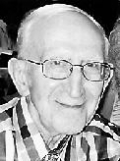 Harry V. Hosso of Phoenix, Arizona, passed away on March 28, 2010 at the age of 88. He was born in Florence, Ohio on January 7, 1922 and grew up in Martins Ferry, Ohio. Harry served in the Army Air Corps during World War II and spent 14 months as a prisoner of war in a German camp. He married Ethel Cisar on July 28, 1945. Upon his graduation from Ohio State, Harry worked as an electrical engineer in Jackson, Michigan. He brought his family to Phoenix in 1961, where he worked at Arizona Public Service until his retirement. He belonged to St. Jerome's Catholic Church, where he was actively involved in St. Vincent de Paul Society and the church financial committee. Survivors include his wife, Ethel, their two children, Robert Hosso and wife Donna, and Susann Traber and husband, Gary, six grandchildren, and three great-grandchildren.
Harry V. Hosso of Phoenix, Arizona, passed away on March 28, 2010 at the age of 88. He was born in Florence, Ohio on January 7, 1922 and grew up in Martins Ferry, Ohio. Harry served in the Army Air Corps during World War II and spent 14 months as a prisoner of war in a German camp. He married Ethel Cisar on July 28, 1945. Upon his graduation from Ohio State, Harry worked as an electrical engineer in Jackson, Michigan. He brought his family to Phoenix in 1961, where he worked at Arizona Public Service until his retirement. He belonged to St. Jerome's Catholic Church, where he was actively involved in St. Vincent de Paul Society and the church financial committee. Survivors include his wife, Ethel, their two children, Robert Hosso and wife Donna, and Susann Traber and husband, Gary, six grandchildren, and three great-grandchildren.
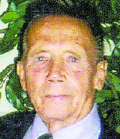 Donald "Smitty" S. Smith, 84, of Newport Road, Duncannon passed away on Sunday, April 11, 2010 in the VA Medical Center, Lebanon. Smitty was born November 2, 1925 at Bedford, Pa. to the late J. Clyde Smith, Sr. and Estella B. (Siebert) Smith. He was preceded in death by a son, Donald S. Smith, Jr., a grandson, Jason S. Smith and six siblings, Clyde, Jr., North, Dean, Gary, Benny and Joy.
Donald "Smitty" S. Smith, 84, of Newport Road, Duncannon passed away on Sunday, April 11, 2010 in the VA Medical Center, Lebanon. Smitty was born November 2, 1925 at Bedford, Pa. to the late J. Clyde Smith, Sr. and Estella B. (Siebert) Smith. He was preceded in death by a son, Donald S. Smith, Jr., a grandson, Jason S. Smith and six siblings, Clyde, Jr., North, Dean, Gary, Benny and Joy.
He was a veteran of WW II Air Force 303rd Bomb Group Hell's Angels Ball Turret Gunner. He had 33 bombing missions over Germany. He had a total of 35 missions and was hit twice with flak. He flew the 100th mission in the Rosie O' Grady plane.
He was a retired grader and other heavy equipment operator for Kimbob, Inc, Harrisburg. He helped build the turnpikes in Pennsylvania, New Jersey, Connecticut and Massachusetts; Interstate 81 interchanges at Rt 81 and Rt 22-322; Olmstead Air Force Base and McGuire Air Force Base.
He was a member of Operating Engineer Local 542, Fort Washington, Pa.; lifetime member of VFW Post 7463, New Bloomfield and American Legion Post 0340, Duncannon.
Smitty loved to play Country Music from a very young age. He taught himself to play guitar, piano, bass, mandolin and the fiddle. He played in bands until he had a family band of his own made up of his children who inherited his gift.
Surviving are his wife of 59 years of marriage, Ida R. (Zimmerman) Smith, four children, Randy L. Smith, Julie L. Reeder, Daniel S. Smith, all of Duncannon, Cathy L. Smith, Newport, four siblings, Denny, Larry, Charlotte, Dotty, nine grandchildren and nine great-grandchildren.
 Ronald "Ron" Duncan passed away at home on March 24, 2010. He was born April 13, 1921, to Robert and Ida Duncan in San Luis Obispo, Ca.
Ronald "Ron" Duncan passed away at home on March 24, 2010. He was born April 13, 1921, to Robert and Ida Duncan in San Luis Obispo, Ca.
Ron grew up in San Luis Obispo, leaving to attend college in Florida. While still in college, he left to join the war effort, becoming a B-17 pilot. Ron was stationed in England, and was shot down over Germany. He survived as a German POW for more than a year. He was liberated in 1945 and came home to San Luis Obispo on leave. While recuperating at his favorite spot, Avila Beach, he met the love of his life, Lucille Kyle, on June 24, 1945. They were married January 11, 1946.
Ron spent his career as an insurance adjuster, first in San Luis Obispo, and then moving to Santa Maria in 1957. Ron was a member of the Elk's for 66 years and had many friends. He will most be remembered for his outgoing personality. He could turn a room full of strangers into a room full of good friends in short order.
Ron was preceded in death by his wife, Lucille, and his son Jeff. He is survived by his son Larry, daughters Caryl and Jill, 5 grandchildren and 4 great-grandchildren.
Wilfred L. Kaliel, Radio Operator on the 427th BS 2Lt David S. Donalson Crew, died May 17, 2009
![]()
Green Hill Belle . . .Keeping the Legacy Alive,
Gary:
Thank you for remembering the brave men who died serving their country April 6, 1945 We are approaching the 65th anniversary of the crash of "Green Hill Belle" in Chemnitz, Germany. That mission was the 35th and last for Lt. Melvin Alderman, our co-pilot who was checking out a new crew that day. Four of the original crew of Lt. Grafton N. Smith completed our 35 missions March 24, 1945. The crew received a three day pass. We planned to celebrate. Mel Alderman also received the pass but declined to go with the rest of the crew because he wanted to complete his missions. He had finished 32 missions. Mel reminded us the group was flying missions on a regular basis at the time and he could finish his missions while we were on pass and all of us could go home together. I will never forget the night of April 6, 1945. We were in a pub in Bedford, England when a number of our friends from the base came in. It was obvious from the look on their faces that something was wrong. They came to us with the heartbreaking news that Mel's plane went down after a collision with another of our planes over Germany. There were no known survivors. We had lost a great friend. He helped bring us back safely from a number of bad missions. He was always there for us.Many years later my wife Lorene and I accompanied by Ed Gardner, navigator on the G.N. Smith Crew were able to visit the mass grave of some of the crew of the Green Hill Belle including Mel Alderman at the Zachary Taylor National Cemetery in Louisville, KY.
Al Dussliere, Waist/Tail Gunner
Hello Gary,
Thank you so much for your assistance in compiling and issuing this special edition on the anniversary of this sad event on 6 April 1945. It is a wonderful tribute to those who did not return to their base on that day, especially the one we were honored to become acquainted through Gene, his uncle Roaul. There were so many similar cases during the air war but this one has been very much researched on location.I am also honored having been in the target area and lived through the followed bombardment with 25 huge craters only 100 yards from the house. It took until 2001 to learn, from our museum's docent Seymour Cohen, about a "midair collision. It was only due to the visit of pilot Howard C. Lacker's sister, Mrs. Dorothy Gosse that we learned about the location of the disaster. It was followed by my research and visit to Loessnitz and subsequent visit by Gene and family to establish an almost complete fact finding.
I wish you further good luck in upkeeping the Pilot and website and a speedy recovery from your operation, which must not have been easy in recent weeks. Many thanks also go to Gene for his valuable contribution.
Thank you so much and best regards, Guenter Bier[Knee replacement surgery - I'm doing very well, thanks! Gary]
Good Morning Gary,
The photo for the Norwood Borror obit in the March 28, 2010 issue of The Molesworth Pilot is not correct. The enlisted men of the Baker crew lived in our hut. The photo you used is that of Neal Fielder. I checked the crew photo on the web site, and the ID's are in the wrong order. There's a poor quality photo of Borror and his wife on page 18 of the May 2006 issue of Hell's Angels Newsletter. Eddie Deerfield.
[Norwood "Woodie" Borror (left) passed away December 17, 2009.]
Did you, or anyone know my father, SSgt Melvin E. Schultz? He flew with Captain Heller. If so, can I get some information? He is gone now and never mentioned much of the war to us. We were all young. He died back in 1983. I am the youngest of his children.
Nancy Schultz, neschultz2005@wmconnect.com


|